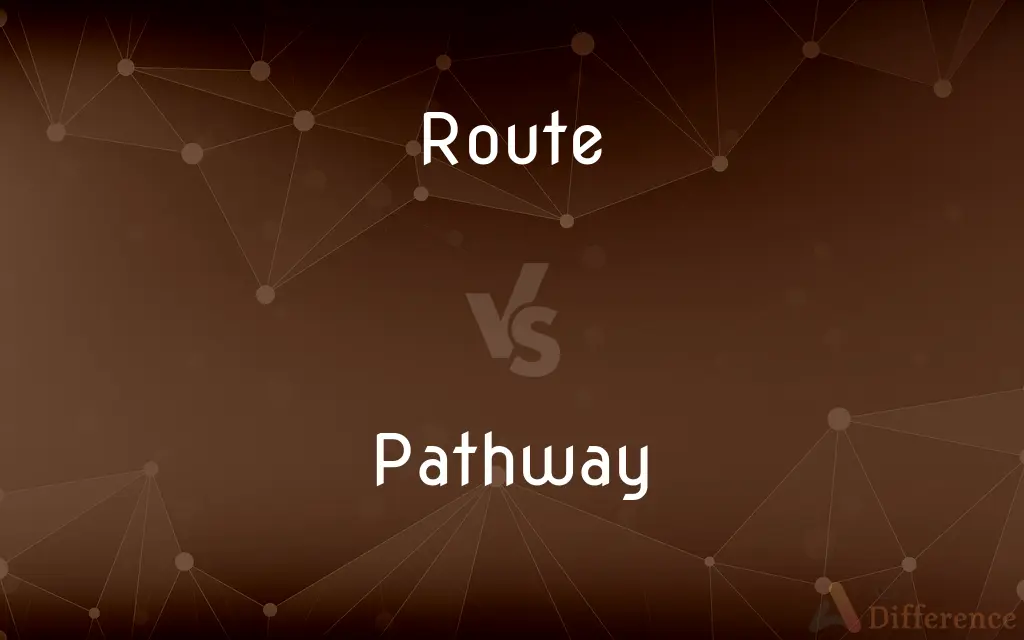Route vs. Pathway — What's the Difference?
By Maham Liaqat & Fiza Rafique — Updated on April 21, 2024
Route refers to a specific course or way taken to reach a destination, typically used in transportation or navigation; pathway usually denotes a smaller, more scenic or pedestrian-focused track.

Difference Between Route and Pathway
Table of Contents
ADVERTISEMENT
Key Differences
A route is generally associated with transportation networks and can include roads, air paths, or sea lanes used for systematic travel. Pathways, on the other hand, often refer to smaller, narrower tracks designed primarily for pedestrian or light traffic use, focusing on accessibility and scenery.
Routes are essential for navigation and are often planned and marked for efficiency, connecting major points like cities or landmarks. Whereas pathways might meander through parks, forests, or between buildings, emphasizing a pleasant journey rather than a quick one.
The concept of a route is integral to logistics and travel planning, highlighting directions and distances between start and end points. Pathways, however, might not always have clear start and end points, as they can be circular or winding, meant for leisurely strolls or short cuts.
In digital contexts, "route" can describe a method or process to achieve a specific function within systems, like data routing in networks. In contrast, "pathway" might be used metaphorically to describe a method of achieving a goal or a series of actions in fields like biology or career planning.
For event organization, choosing the right route is crucial for managing traffic and ensuring timely arrivals. Whereas selecting pathways is important in designing enjoyable and safe environments for attendees to navigate spaces like festivals or conferences.
ADVERTISEMENT
Comparison Chart
Definition
A course taken for reaching a destination
A track designed primarily for foot traffic
Usage
Navigation, travel, transportation
Walking, cycling, leisure
Planning
Often planned for efficiency
Planned for aesthetics and accessibility
Typical Locations
Roads, airways, sea lanes
Parks, forests, campuses
Contextual Meaning
Logistic routes, data routing
Biological pathways, career paths
Compare with Definitions
Route
A designated course for reaching a destination.
The bus took a new route due to construction.
Pathway
A metaphorical route to a result.
The book outlines a pathway to personal fulfillment.
Route
A method or way of doing something.
You can take the quickest route to success with the right plan.
Pathway
A track designed for pedestrians.
The pathway through the woods leads to a secluded lake.
Route
A series of stops or destinations on a journey.
The delivery driver has eight more stops on his route today.
Pathway
A physiological or biochemical route in an organism.
This medication works by blocking a specific biochemical pathway.
Route
A way or direction followed by a set pattern.
The migration route of the birds spans several continents.
Pathway
A sequence of actions or processes.
The pathway from raw data to useful insights involves complex analysis.
Route
A path through which electricity flows.
The electrician checked the route of the wiring in the building.
Pathway
A method or way of achieving something.
Choosing the right subjects in school can set you on a successful career pathway.
Route
A road, course, or way for travel from one place to another
The route from Maine to Boston takes you through New Hampshire.
Ocean routes that avoided the breeding grounds of whales.
Pathway
A path.
Route
A highway
Traveled on Route 12 through Michigan.
Pathway
A course usually followed by a body part or process.
Route
A fixed course or territory assigned to a salesperson or delivery person.
Pathway
A chain of nerve fibers along which impulses normally travel.
Route
A means of reaching a goal
The route to success required hard work.
Pathway
A sequence of enzymatic or other reactions by which one biological material is converted to another.
Route
(Football) A pass pattern.
Pathway
A footpath or other path or track.
Route
To send or forward by a specific route.
Pathway
(biochemistry) A sequence of biochemical compounds, and the reactions linking them, that describe a process in metabolism or catabolism.
Route
A course or way which is traveled or passed.
The route was used so much that it formed a rut.
You need to find a route that you can take between these two obstacles.
Pathway
(figurative) A course of action.
Route
A regular itinerary of stops, or the path followed between these stops, such as for delivery or passenger transportation.
We live near the bus route.
Here is a map of our delivery routes.
Pathway
A footpath; a beaten track; any path or course. Also used figuratively.
In the way of righteousness is life; and in the pathway thereof is no death.
We tread the pathway arm in arm.
Route
A road or path; often specifically a highway.
Follow Route 49 out of town.
Pathway
A bundle of mylenated nerve fibers following a path through the brain
Route
(figuratively) One of multiple methods or approaches to doing something.
Pathway
A trodden path
Route
(historical) One of the major provinces of imperial China from the Later Jin to the Song, corresponding to the Tang and early Yuan circuits.
Route
(computing) A specific entry in a router that tells the router how to transmit the data it receives.
Route
(horse racing) A race longer than one mile.
Route
(transitive) To direct or divert along a particular course.
All incoming mail was routed through a single office.
Route
(Internet) to connect two local area networks, thereby forming an internet.
Route
To send (information) through a router.
Route
The course or way which is traveled or passed, or is to be passed; a passing; a course; a road or path; a march.
Wide through the furzy field their route they take.
Route
An established line of travel or access
Route
An open way (generally public) for travel or transportation
Route
Send documents or materials to appropriate destinations
Route
Send via a specific route
Route
Divert in a specified direction;
Divert the low voltage to the engine cylinders
Common Curiosities
What role do routes play in urban planning?
In urban planning, routes are crucial for designing efficient traffic flow and public transportation systems to connect various parts of a city effectively.
Are routes always visible?
Routes may not always be physically visible, especially in cases like air or sea navigation where navigational instruments determine the route based on coordinates.
What is the impact of technological advancements on route planning?
Technological advancements like GPS and digital mapping have significantly improved the accuracy and flexibility of route planning, enabling real-time adjustments and optimization.
Do pathways have to comply with accessibility laws?
Yes, pathways, particularly in public areas, must comply with accessibility laws ensuring that they are navigable by people with disabilities, including those using wheelchairs.
How do emergency situations affect the use of routes and pathways?
In emergencies, routes may be altered or designated as priority lanes for emergency vehicles, while pathways can be used for evacuation purposes or temporary access.
What are some examples of digital pathways?
In digital contexts, pathways can refer to user journeys on websites, steps in software workflows, or progressions in educational software.
How do routes and pathways enhance leisure and tourism?
Routes can enhance tourism by providing access to multiple attractions efficiently, while pathways enhance leisure experiences by offering scenic or thematic walks.
What materials are commonly used to construct pathways?
Pathways are typically constructed from materials such as gravel, stone, wood chips, or concrete, depending on the intended aesthetic and functional use.
How do weather conditions affect routes and pathways differently?
Weather conditions can severely affect routes, especially in aviation and shipping, requiring rerouting. Pathways may become unusable or hazardous, like when covered with ice or snow.
Can pathways serve a cultural or historical purpose?
Yes, many pathways are designed to highlight cultural or historical areas, serving as educational trails or heritage walks that offer insight into local history and culture.
What are common maintenance challenges for routes and pathways?
Common maintenance challenges include wear and tear from weather and use, the need for regular resurfacing, and managing vegetation or obstructions that may hinder accessibility.
How are routes determined in wilderness areas?
In wilderness areas, routes are often determined by natural landmarks and terrain, with marked trails to minimize the environmental impact and preserve the natural setting.
What safety considerations are specific to pathways?
Pathways require safety considerations such as adequate lighting, clear signage, and regular maintenance to prevent accidents, especially in areas frequented by pedestrians and cyclists.
Can both routes and pathways be temporary?
Yes, both can be temporary, such as routes designated for special events or temporary pathways set up in construction areas or during festivals.
Are there environmental impacts associated with creating new routes or pathways?
Creating new routes or pathways can have environmental impacts, including habitat disruption and increased pollution. Careful planning and environmental assessments are crucial to minimize these effects.
Share Your Discovery

Previous Comparison
Amsterdam vs. Holland
Next Comparison
Spiral vs. SpiralledAuthor Spotlight
Written by
Maham LiaqatCo-written by
Fiza RafiqueFiza Rafique is a skilled content writer at AskDifference.com, where she meticulously refines and enhances written pieces. Drawing from her vast editorial expertise, Fiza ensures clarity, accuracy, and precision in every article. Passionate about language, she continually seeks to elevate the quality of content for readers worldwide.
















































